-
Posts
1,728 -
Joined
-
Last visited
Content Type
Profiles
Forums
Store
Help Articles
Posts posted by Jonathan Day
-
-
You are wise to avoid Cannes during the festival.
The Moulin de Mougins changed hands last year; the new chef is Alain Llorca. I've had both promising and not so promising meals there. In Mougins, try Le Bistrot de Mougins (in the village); Côté Mougins (outside it). In Biot, Les Arcades is simple but good. At the higher end, Hostellerie Jérome in La Turbie can be good. I have had some very good meals at Jacques Chibois's place in Grasse, Bastide St Antoine, though some don't like it.
I've recently been disappointed by Maximin's place in Vence. The service has been haughty and the food uneven.
All the high end places (almost anything listed in Michelin) will be crowded during the festival.
I haven't been to the Auberge de la Madone, in Peillon, in several years, but it was once quite wonderful. Peillon is a tiny perched village, high in the hills above Nice.
Search a bit on this forum and you'll find more reports!
-
Of course it's hard to generalise. I have seen French children dining in front of the television, eating frozen foods, leaving the table mid-meal, etc. It absolutely isn't true that every French family has three generations at every dinner, slowly eating vegetables from the garden, artisanal cheese from the farm next door, extra virgin olive oil blah blah blah.
And yet the French families I have known (quite a number now; we spend lots of time there every year and have three children who have exchanged with French students over multiple years) tend to be tougher with children and meals than either British or American families we know.
Just two examples from many I could cite:
- A French mother in London, worried that her 4 children would pick up "foreign" sensibilities; she forbade them from eating meals at friends' houses. The dinners she prepared for their children were classic French -- 3 courses, no holds barred. My wife and I quizzed her. Tripe? Yes. Brains? Yes. What if the children didn't like it? Then, she said, they went to bed hungry. Eventually she insisted on the family moving back to Paris, even though the husband preferred the business environment in London. I should add that her children were very thin...
- A 14 year old French exchange student who has visited us several times, in London and in France. He sat politely at every meal and ate everything we served: vegetables, stinky cheeses. He didn't expect pudding (dessert) at every meal. My son and I had lunch at his family's flat in Paris. Three young children, two guests, small table, four courses. Our children are well behaved, but not that well behaved.
I wonder whether there a parallel to the French state school system, which tends to be more rigorous and competitive than the British -- which is in turn, generally, tougher than most state schools in the US.
-
-
Here's a mystery, at least as puzzling to me as the observation that French women don't get fat and that French people, despite guzzling wine, smoking cigarettes, and eating fatty foods don't seem to get heart attacks.
Why is is that French children -- some as young as 3 years old -- can often sit through a long, multi-course meal, sometimes lasting 4 hours, without melting down, screaming, complaining? I've seen children younger than ours maintain perfect decorum through long menus at one-, two- and three- star restaurants, where ours (who tend to be better behaved at fancy meals than many of their age group peers) can only last an hour or so before needing to leave the table, go play, or generally raise a fuss?
How do the French accomplish this? Is it doses of wine in the feeding bottles?
-
it did raise some thoughts about the problems inherent in developing techniques so new to professional kitchens that it takes time for health inspectors to keep up.
A++ for cheek.
I'd only give him a B- for cheekiness. It's true that TFD has experimented with (and Heston Blumenthal written about, in books and articles) cooking foods at extremely low temperatures for long periods of time. The health inspectors must have had concerns about meats cooked at temperatures lower than those they considered safe.
For the avoidance of doubt, and of a repeat of the accusations elsewhere on this topic: let me stipulate that Blumenthal isn't the first to have experimented with low-temperature-long-time cookery, and that he has had sweetbreads cooked in a hay box for as long as I can remember. Nonetheless, I'm not surprised that the inspectors might have had questions about his techniques.
-
Dirk, I was praising the Gastroville Bloggers for setting out their criteria and evaluating TFD against it. Very, very few reviewers (online or in print) do that. The Michelin inspectors try to keep their criteria secret. Mikael and Vedat have set theirs out for others to see and debate. Kudos to them for that.
I hold to my view that debates about "the best" restaurant, without criteria, are a waste of time...as are lists purporting to tell us the "best" restaurants around.
As Andy said, there is no eGullet line on The Fat Duck, or on any other restaurant.
-
If there's one thing that has become clear to me since first joining eGullet, it is that arguments about "who knows more about food?" almost never get anywhere. Apart from the fact that "food knowledge" is multidimensional (geography, history, science, aesthetics, etc.), it is a topic that is deeply contextual. Another way of framing Moby's point is that the chef's experience of a dish or a meal is invariably different from that of the diner. So I propose that we set aside any question about who knows more, or who is qualified to criticise whom.
I give Mikael and Vedat, the Gastroville bloggers, substantial credit for setting out, clearly and at the very start of their blog, the food rating standards by which they compute their scores. In essence, they are setting out a personal culinary philosophy. My reading of their reviews is: "this is what we look for in a restaurant. If this is what you seek, the scores will be a good predictor of your experience. If you are looking for something different, the scores, the reviews and the blog may be less useful." For example, their ratings and other comments on their blog suggest that they give relatively little rating to ambience or service -- for them, the food is the food, whether served on Limoges or a piece of cardboard. Some of their criteria are necessarily matters of individual judgement -- for example, the notion of the "magic touch of the chef." But others would be easier for multiple raters to agree on.
Seen in that light, their take on the Fat Duck is more a matter of its performance against a very specific and personal aesthetic; against that, they found it promising but still somewhat wanting. Heston's philosophy may be different to that of the Gastroville Bloggers. Fortunately, we can now examine their criteria (see link above) and Heston Blumenthal's, in his books and Guardian columns. To me, that conversation would be more interesting than another sterile debate about whether The Fat Duck (or any other restaurant) is on some absolute scale "the best" in Britain, Europe, or the world.
-
I suggest you guys start again something like Symposium where we used to discuss interesting side topics which engendered many interesting discussions and good insights.
We don't need to, Vedat. It already exists. Go to the following website:
forums.egullet.org
-
Some people I trust reported that l'Atelier was much better right after its opening and has declined steadily. ... My best guess is that they are run according to a corporate mentality with 20 something MBAs who put pressure on their supply chains for ever cheaper prices and steady delivery of ingredients irrespective of seasons as they are only concerned about the corporate "bottom line". They want to generalize this model as a toned down version of 3 star cooking for contemporary diners. Their is a gap between portrayal and delivery. To me, to borrow from Marc diBiaso, this is a gourmet McDonald model. ...
I found that the servers were under the instruction to either push the client to order more or get him/her out to maximize turnover. It works. I won't be surprised if some management consultant wise kids came up with the model and recommended the seating arrangements, including the outside sliding doors which opens only one way.
I hope that even though I am one of these dastardly management consultants my views won't be written off.
In my experience it is very difficult to create a restaurant, or any business, that communicates the kind of attention to the quality of product or service that one experiences at a place like L'Ambroisie. Sadly, it is very easy to go the other way. You can get things wrong either, as Vedat suggests, by focusing on the bottom line rather than the product itself, or (and this is more common) simply by getting things wrong, in other words by not paying attention to detail, getting sloppy about standards and quality, etc. In most cases, the businesses that do this tend to be unprofitable as well. There may be exceptions for restaurants and hotels aimed at single-visit tourists, where mediocre delivery doesn't cramp demand even though customers rarely return.
Paradoxically, it's often a good recipe for a business to ignore the bottom line, for the most part, and to focus almost exclusively on delivery and the customer. Of course someone needs to look at the financial output of the business: if the balance sheet doesn't balance or the P&L is persistently in the red, the company will close. But most employees' attention should be focused elsewhere.
That's the advice I tend to give my clients -- but then, I'm neither the holder of an MBA nor 20-something any longer.
I think I should separate mentality from profession. Given certain incentives at place, management consultancy profession, esp. its high end which I will call "strategic consultancy"(Jonathan correct me if I am wrong) does attract some of the best and brightest in the US and I expect the 3 or so top firms to be especially careful in their recruitement policy and not to promote the type of mentality that I think encapsulates the type of business practice I attributed to l'Atelier. On a personal level I will actually make the more dashing comment(nobody should take personally) that those in management consultancy, esp. it they made it to the partnership status in the 3 or so firm I mentioned, are more rounded, intellectual, artistically sensitive and interesting(a subjective opinion)people than the academic professors with whom I interact. So it will be an "ecological fallacy" to deduce personal characteristics from a structural feature I attributed to the management consultant practice. On the other hand, management consultants mostly hire MBAs and "cost cutting" seems to be the first thing in mind that these 20 somethings focus when they get their hand dirty in the field. I have a strong hunch that L'Atelier restaurants are more preoccupied with the rationalization and standardization of their supply chain today than other aspects of business. Given the paucity of gourmets who can judge ingredients among their international clientele, and given the fact that they delivered at a higher level when they began and built some goodwill, their business model may work just fine. But their will always be some minority voices like mine, or Whiting's, or Marc's, or Mikael's, or Robert,s etc. who will cry "foul" from the sidelines.
The top firms charge so much for their services that it's highly unlikely that any restaurant, outside of a big chain like McDonald's, could afford to hire them. Unless a business has a turnover of (roughly) $1bn/year, the firms at the top of the profession won't be particularly interested in them. And I can assure you that "cost cutting" is not at all a favourite activity, either for the partners or for those 20-something MBAs.
I do think Vedat is onto something: an exceedingly commercial focus, one that says, "charge every penny that the market will bear" and "reduce costs until the customers start to defect." While correct from an caricatured view of economic rationality and opportunism (one that says, e.g. that I would pick the pockets of my dinner guests if I didn't fear getting caught), this kind of behaviour is almost never good business.
But I don't see this as having much to do with management consultants! Most of the top firms do a lot of work generating customer loyalty. Here's Bain: "Strategically align the interests and energies of employees, customers, suppliers and investors, in a self-reinforcing cycle". McKinsey, Monitor, BCG would all say similar things.
You could argue that it's private equity firms (which are more likely to be involved with restaurant groups) that are to blame: see this cogent essay by the British economist, John Kay.
In any event, I suggest we get back to Paris and the food...
-
Some people I trust reported that l'Atelier was much better right after its opening and has declined steadily. ... My best guess is that they are run according to a corporate mentality with 20 something MBAs who put pressure on their supply chains for ever cheaper prices and steady delivery of ingredients irrespective of seasons as they are only concerned about the corporate "bottom line". They want to generalize this model as a toned down version of 3 star cooking for contemporary diners. Their is a gap between portrayal and delivery. To me, to borrow from Marc diBiaso, this is a gourmet McDonald model. ...
I found that the servers were under the instruction to either push the client to order more or get him/her out to maximize turnover. It works. I won't be surprised if some management consultant wise kids came up with the model and recommended the seating arrangements, including the outside sliding doors which opens only one way.
I hope that even though I am one of these dastardly management consultants my views won't be written off.
In my experience it is very difficult to create a restaurant, or any business, that communicates the kind of attention to the quality of product or service that one experiences at a place like L'Ambroisie. Sadly, it is very easy to go the other way. You can get things wrong either, as Vedat suggests, by focusing on the bottom line rather than the product itself, or (and this is more common) simply by getting things wrong, in other words by not paying attention to detail, getting sloppy about standards and quality, etc. In most cases, the businesses that do this tend to be unprofitable as well. There may be exceptions for restaurants and hotels aimed at single-visit tourists, where mediocre delivery doesn't cramp demand even though customers rarely return.
Paradoxically, it's often a good recipe for a business to ignore the bottom line, for the most part, and to focus almost exclusively on delivery and the customer. Of course someone needs to look at the financial output of the business: if the balance sheet doesn't balance or the P&L is persistently in the red, the company will close. But most employees' attention should be focused elsewhere.
That's the advice I tend to give my clients -- but then, I'm neither the holder of an MBA nor 20-something any longer.
-
One more note. We were surprised at the Tunisian wines, which were drinkable and not too expensive. It was more than pleasant to sit in the sun, eating perfectly grilled fish and drinking Gris de Tunisie, a rosé.
-
Here are a few more market photographs, from Homt Souk and Guelalla, on Djerba, and Tataouine, on the mainland.
As I noted above, despite a profusion of vegetables in the markets, the restaurants (both independent and in hotels) seemed to have a limited selection. Some of the smaller restaurants didn't offer anyone a menu -- you sat down at shared tables, and they brought everyone the same meal: bread, with olive oil and harissa; a brik, couscous, usually with lamb, and some sort of pastry, often cornes de gazelle. This was followed by mint tea. It was often good, but I wondered where the fava beans and peas I saw in the markets were going.
I'm sure that this is the same phenomenon as the tourist in France who doesn't speak the language and wonders how the French survive on nothing but bread and steack frites. That said, the brik-and-couscous restaurants I described above were catering more to locals than to tourists.
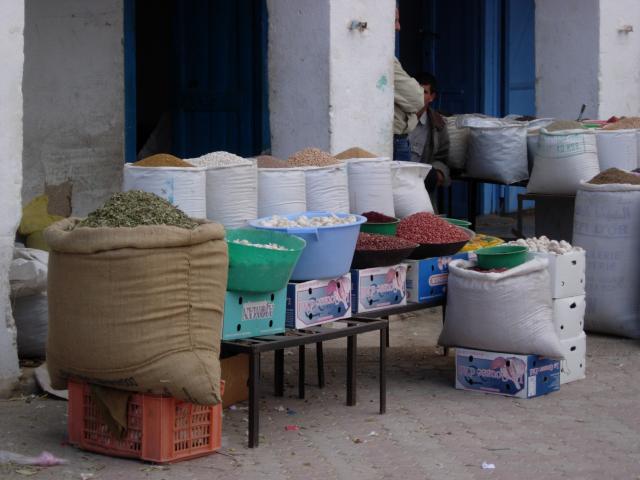
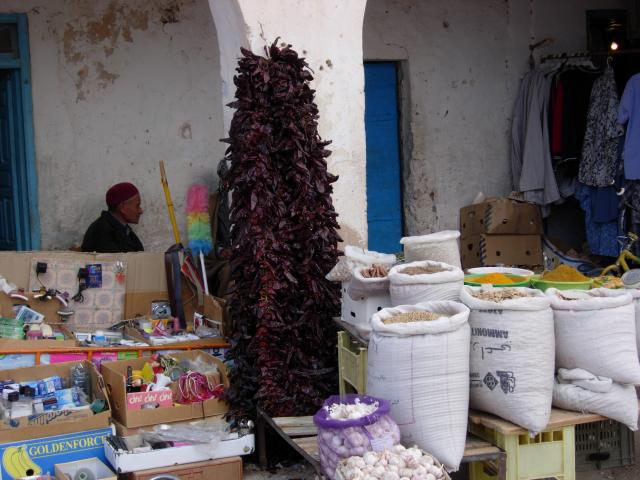

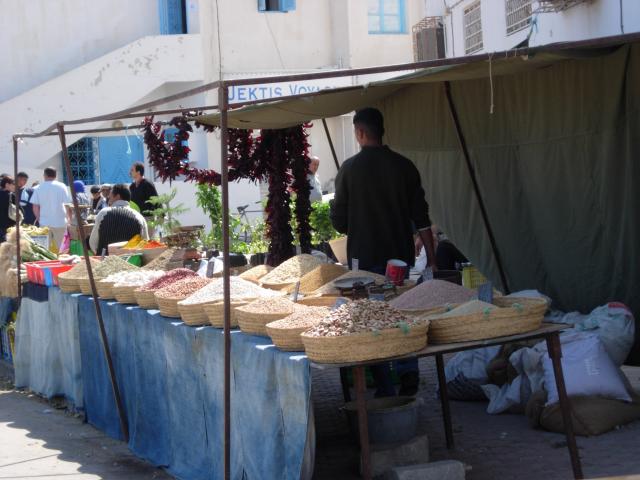
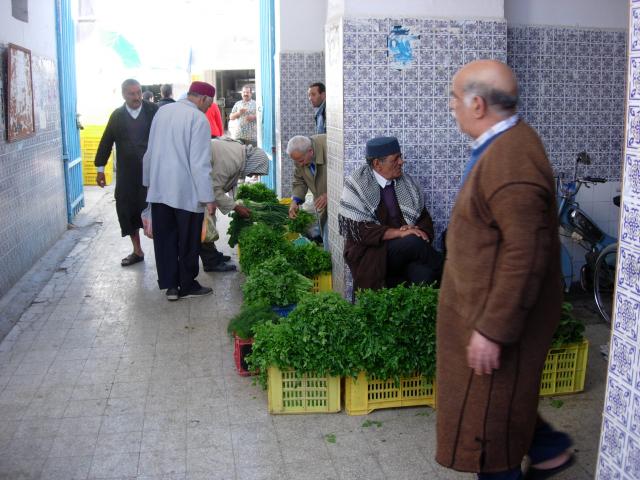

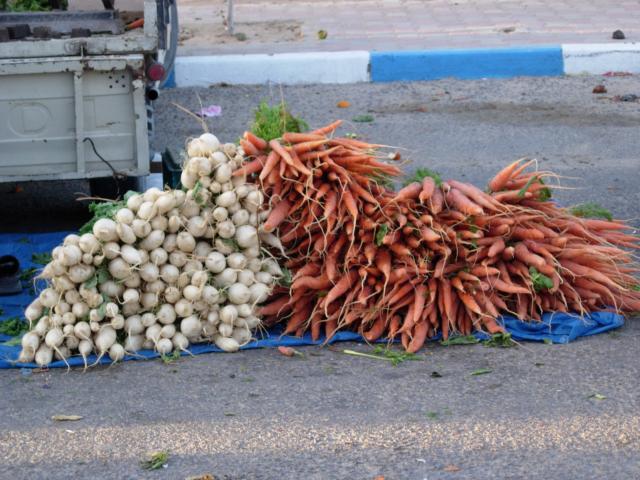
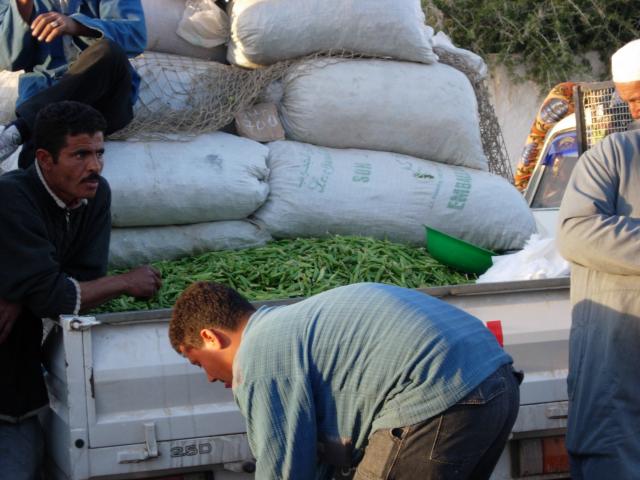
-
We didn't travel to Tunisia for the food, but it was good and interesting nonetheless.
As Paula noted, there was a great market in Homt Souk on Monday. The vendors turn up Sunday afternoon to secure the best places; the fish auction starts early on Monday morning.
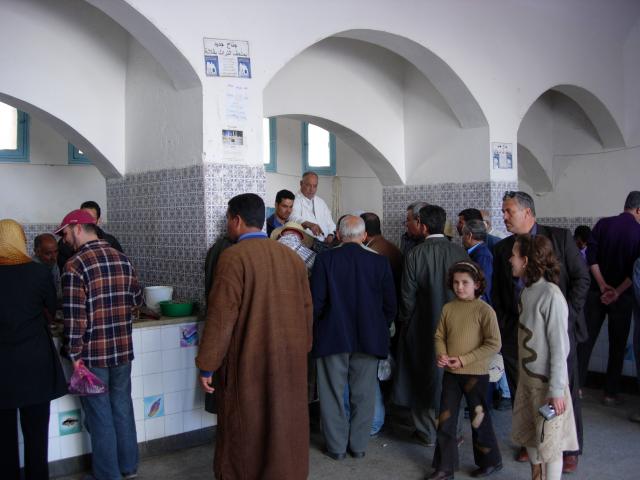
The fish auction -- attended mostly by men, but one auctioneer seemed be selling primarily to women.
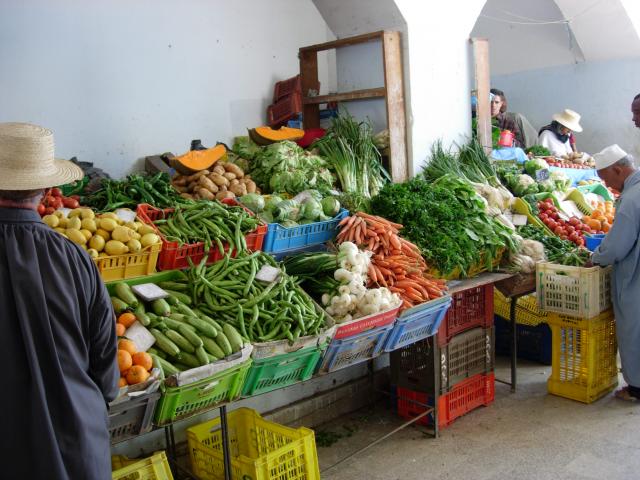
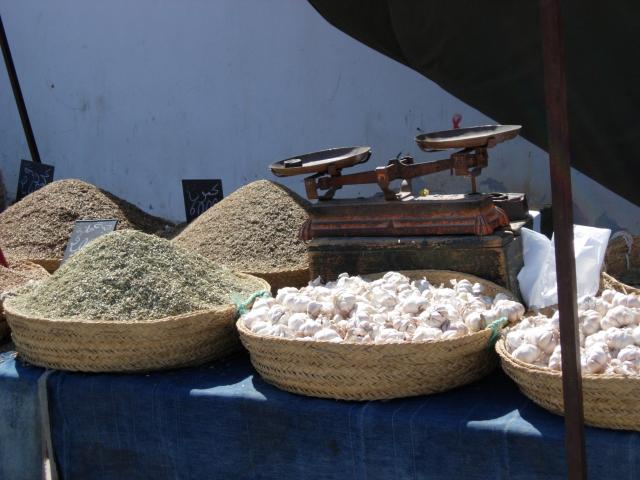
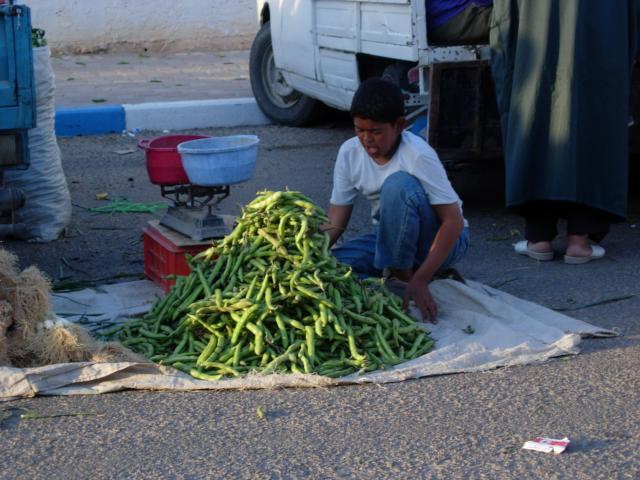
We saw lots of interesting vegetables in the markets, but the same variety didn't turn up in hotels or restaurants. No complaints about the fish, though, which was universally fresh.
Distances and directions seemed more vague and relative than I had expected. We had been directed to a newly opened restaurant called "Safran", in Homt Souk, but nobody seemed to know where it was. But that didn't stop them from offering directions. "Not far from here," said a policeman. "Straight ahead, then to the left." (Tout droit, puis à gauche). We tried this, only to end up in another part of the market. "Yes, I've heard of Safran," said a trader; "tout droit, puis à gauche". Another wander. "Safran," mused a shop owner. "It isn't here. Go tout droit" ... you guessed it.
Hence I started asking about Chef Haouri from the moment of our arrival. Yes, people said, he's very well known. You will like his cooking. Where was his restaurant, we asked. "It isn't in town," said a taxi driver. But where was it? "Ask at the hotel, they will know."
Yes, "Chef Haouri," said the hotel manager. "It's across from the Casino. Leave the hotel, go straight ahead, then turn left."
Eventually I set out on foot. Straight ahead, across from the Casino, and to the left was a smoky café that could not possibly have fit Paula's description; but I went in nonetheless. "Ah," said an old man, "it's right over there." He took me outside and we walked for a ways...and there it was, not across from the Casino, but from a resort called the Sun Club.
The restaurant itself was not prepossessing. Signs indicated that it was a pizzeria, though there was a faded review from the Guide Routard pinned to a post. Inside, though, the place was simple. At the back of the room was a sandwich making stand and pizza oven, in which quite a few of the dishes were prepared.
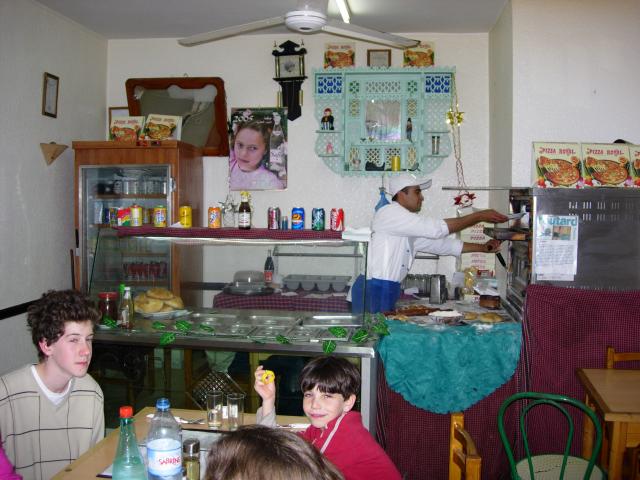
We had made contact with the chef by phone, so a dinner had been chosen and prepared for us. There was a chachouka, made with onions, peppers, tomatoes and eggs...
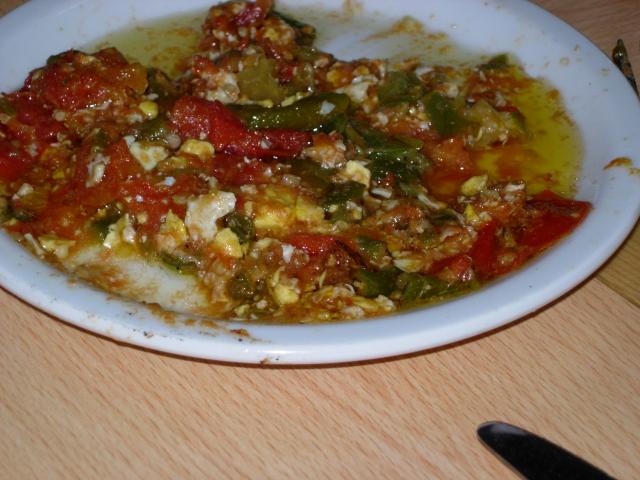
...and a light, crisp brik, stuffed with eggs and herbs, by the far the tastiest of many we tasted while in Tunisia.
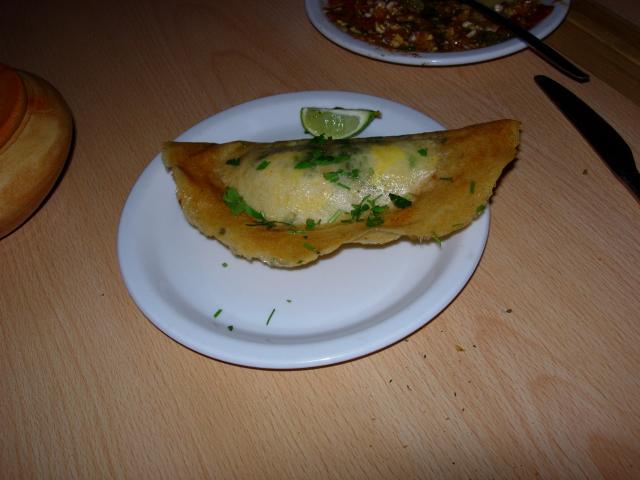
Then the chef's son removed two blackened pots from the oven; they had been sealed with bread dough.
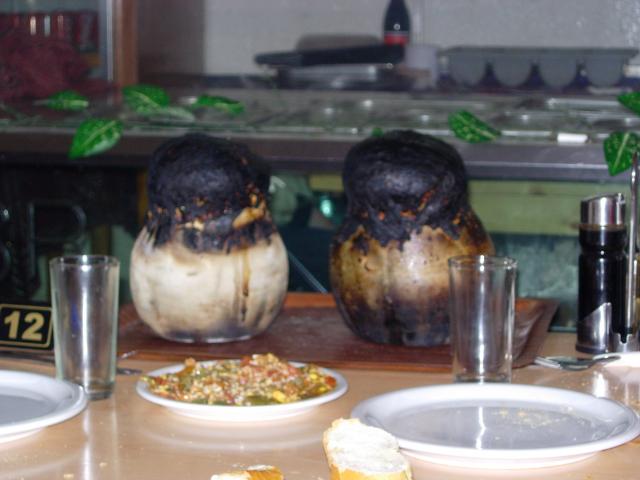
He carefully sliced off the tops
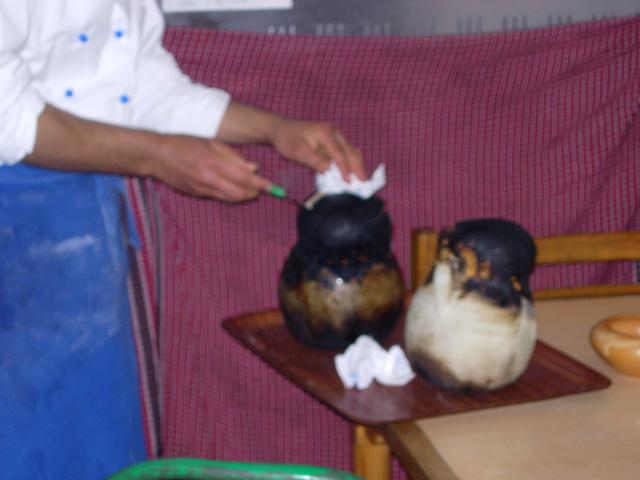
and poured out a wonderfully fragant stew, the gargouillete, made with lamb and root vegetables.

Yes, it smelled that good.
While we ate this, the chef's son made pizzas and enormous sandwiches for other customers. The bread we encountered in Tunisia was, for the most part, more like traditional French bread than the flat breads I had been served in other parts of Northern Africa. Chef Haouari's was freshly made -- in that same oven, of course -- and delicious. The restaurant was sparkling clean, and the chef and his son constantly moved around, cleaning, straightening chairs, wiping down tables.
Chef Haouari explained that the lamb in our gargouillete was a year old; this dish, he said, didn't work with either very young lamb or mutton. It was tender and the flavours were almost perfectly balanced.
We ended with dessert
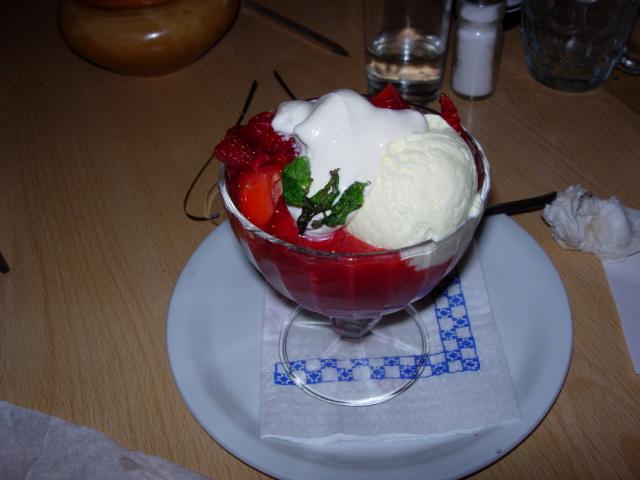
and a quick lesson in how to fold a napkin into a flower.

The chef sent us home with a selection of his pastries, among them cornes de gazelle, crescent-shaped and filled with honey and nuts. We tasted a number of these on our trip, but none were as crisp and light or well-flavoured as Chef Haouari's.

We talked about bread, and cooking, and Chef Haouari's own experiences. He has cooked all over the world -- at the CIA, with Tetsuya, and all over France. As Paula indicated, he admires Alice Waters. On his return from Chez Panisse, he opened a more haute cuisine restaurant, with a fireplace over which foods were cooked. But he didn't serve alcohol, and customers simply weren't prepared to spend money unless they could have wine with their meals. Hence the return to a simple sandwich shop and pizzeria. "He loves the Djerbian ways," one of the locals told us; "and he wants to keep his life simple and balanced."
On the morning after dinner at Chef Haouari's restaurant we departed for the desert. This was not the most gastronomically interesting part of the trip, but there were some unusual moments. We stopped at a ksar, still used by families to store oil, grains (mostly barley, orge rather than semolina or wheat) and, in large jars, confit de chameau, camel confit. Each family has a chamber in the ksar; each door is locked with a different complicated, coded latch mechanism, and the secret passed along within families.
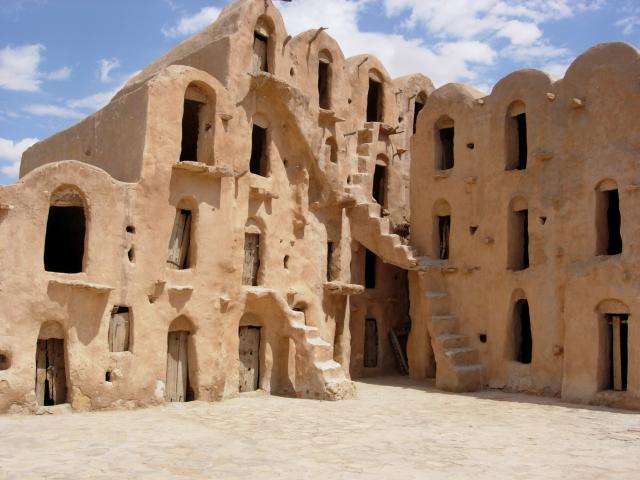
Camel confit is made by melting the fat in the camel's hump, cooking the meat, just like duck confit, and storing the result in large jars, where it keeps for over a year.
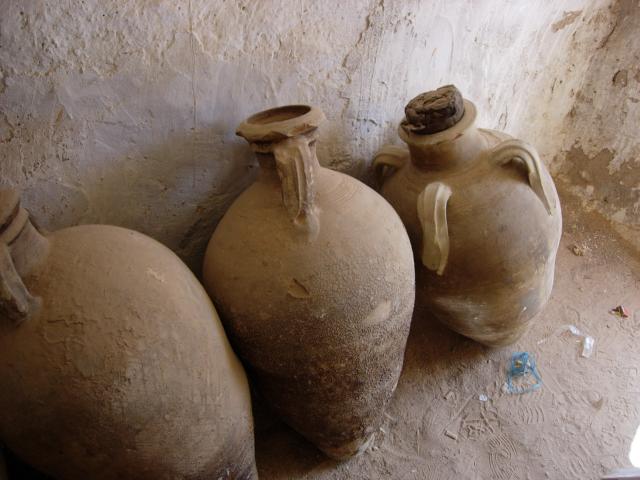
I believe the jars above were used for olive oil.
We stopped at the troglodyte dwellings; in one, the owner brought us bread that was closer to the Arab breads I had expected. This was round and flat, but about 2 cm thick; it was flavoured with saffron.

George Lucas fans may note some similarity to Luke Skywalker's house in the Star Wars film made in the 1970s. That's because one of these dwellings -- now a hotel, the Sidi Driss -- was used as the set. Scribbled markings from the production are still on the backs of doors.
We spent a few days at Ksar al Ghilane, a desert oasis watered by a natural hot spring.


Very basic eating here; some local women had painted a sign, "BOULANGERIE DU DESERT" (The Desert Bakery). They prepared bread over a fire, on a round metal pan.
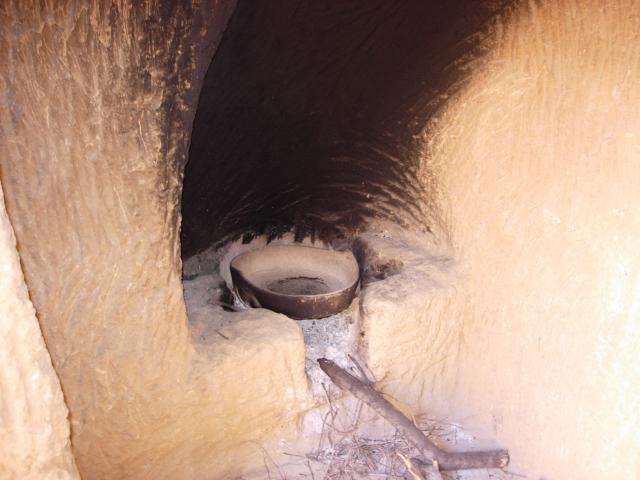
We returned via Djerba, and one more trip to Chef Haouari's restaurant. This time, his son made several pizzas for us; they were light and delicious. My daughter desperately wanted pasta, and soon a dish of spaghetti bolognaise arrived; the sauce was deep, rich, and well flavoured. The adults wanted salads, after the desert, and Chef Haouari made mechouia with tomatoes, onions and tuna. Finally, we had grilled chicken and a grilled sea bass. All of this food was, literally, beautiful: not in the same way that Pacaud produced exquisite, pure dishes at L'Ambroisie, but prepared with very fresh ingredients and perfectly balanced in seasoning.
Chef Haouari drove me back to our hotel. He explained that the restaurant was filled, day and night, during the high season; it never closed, 7 days of the week, 24 hours a day. That must be exhausting for you, I remarked. It is the service I owe my customers, he said.
We hadn't travelled to Tunisia to eat, but the trip helped me resolve an issue that we have discussed at great length on these pages. Could cookery be art? Chef Haouari is, unquestionably, an artist; he has found his vocation, creating a tiny gem of a restaurant in which he can serve the foods he loves. Yes, these dishes feed the body and eventually pass out of it, but their making is done with care that goes far beyond craft or technique.
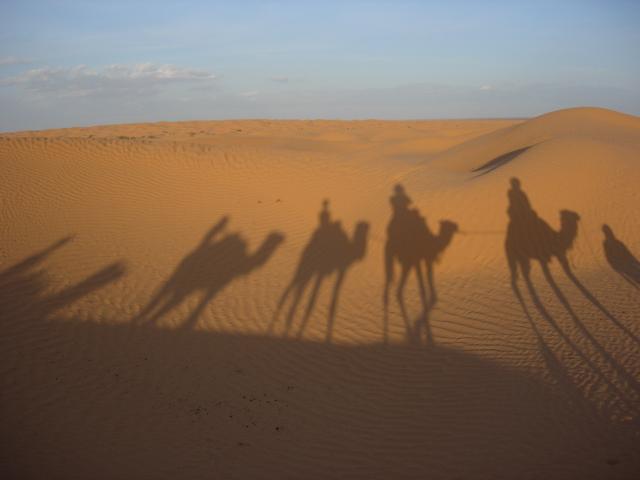
-
And another, Il Lago at the Manoir de l'Etang, in Mougins. The Manoir is a lovely, old 20 room hotel, near a small lake ("l'etang") filled with waterfowl, a bit outside the old village. They formerly had a decent but not particularly special French restaurant.
Now the entire hotel has been redecorated in lighter and more modern tones, and the restaurant has become Italian -- but this is close to what you'd find over the border in Italy. The chef and brigade come from Naples. We had an outstanding chick-pea soup, a very good risotto, and simply but correctly grilled lamb chops and entrecotes, with beautifully selected porcini. Dessert, a souffle of Limoncello, was almost perfect. They don't have a set menu, so you can compose your own from antipasti, primi, secondi, dolci -- a pleasant change after too many set menus priced so that you would hesitate to order from the carte.
You might not travel from Italy to go to Il Lago, but it's a good addition to the many restaurants in the area. And for those seeking a hotel in these parts, the newly decorated Manoir de L'Etang looks like a winner.
Il Lago, 66 Allee du Manoir, in Mougins -- telephone 04 92 28 36 00. You leave the village, heading for Valbonne, but at the first roundabout follow the signs for the Manoir de L'Etang. It's no more than a 5 minute drive from the village.
-
Here's another one to add to your list: Mantel, 22 rue St Antoine, in le Suquet in Cannes; telephone 04 93 39 13 10.
Noel Mantel, the chef, worked under Ducasse. The cooking is fresh and well balanced, with good ingredients; the courgette flower beignets are beautifully light. Mantel's cookery is just slightly Italianesque. The restaurant is small but elegant. We've dined there three times and enjoyed it a lot.
-
As promised, we went to the Feu Follet for dinner last night. This was a first visit in something over 3 years.
At first, our hopes were raised -- this place has a near-perfect location in the centre of the village; the restaurant looked well cared for; our table was on the terrace, with a little sea of lovely flowers just outside the window; and the welcome was friendly. Olives were tasty, and the menu and wine list looked fresh and interesting. Interesting local wines of quality were well represented, e.g. Palette (ch. Simone), Bellet (Clos St Vincent), Bandol (Domaine Tempier, etc.).
I tasted:
- Escargots in cream sauce with garlic
- Foie gras ravioli with mushroom sauce
- Foie gras terrine
- Rognons (kidneys) in mustard sauce
- Roast duck
plus a few desserts.
The Feu Follet has improved a lot since our last visit. Where the service a few years ago was cold and slapdash, this was skillful and friendly. None of the dishes was terrible.
And yet something was consistently missing, out of balance, like an orchestra that had failed to tune up. Flavours in the snail dish were surprisingly thin, except for bits of garlic that hadn't been cooked enough and were acrid tasting. The foie gras terrine had an odd second taste. Roast duck was overly sweet. Kidneys had good texture, though they weren't served "rose" (pink) as requested, but the sauce was watery and the mustard really didn't come through. The ravioli dish was the best of any we were served.
Desserts, e.g. a chocolate "pyramid", had strong elements, but even here there were inconsistencies. Even the madeleines served after dinner were not quite right.
My sense is that the restaurant is trying harder, but that more attention is needed to flavour and balance -- a final taste, perhaps, before dishes leave the kitchen. The place has great history and potential, and it shouldn't take a heroic effort to improve it.
In the guide that we give to visitors to Mougins, we had advised against visiting the Feu Follet -- this after dreadful food and bad service a few years ago. We'll withdraw this advice, and we'll hope to see further improvement.
And yet it's hard to be wildly excited about the Feu Follet with so many stronger restaurants in the area. Tonight, for example, we dined at L'Auberge Fleurie, in Valbonne, a 10 minute drive from Mougins. Every dish was interesting, and the cooking was confident and skilled. And the bill, for three, was 10 Euros less than at the Feu Follet, and with a better bottle of wine (ch Le Caillou, 1993).
-
Just to make sure we are all on the same page: Chickpea flour which used to be cheaper than white flour made from wheat is used to make socca in Nice and farinata in Genoa.
In fact, in every Mediterranean coastal town there is a grainy snack food made with the flour.
Tunis: fenugreek flavored butter cookies called ghoriba homs
Tangier: cumin flavoerd, egg based pudding called karantika
Gibraltar: ditto
Israel: falafal
Antalya, Turkey: Hibes (a type of hummus made with the flour and tahini)
Palermo: panelle
Cadiz: Tortillitas
Please feel free to add to the list. I'm looking for more references
And don't forget panisses (no relationship to Chez P., the Berkeley, California restaurant): the chickpea flour is cooked, rather like a polenta, put into a mould and cooled; the unmolded product is sliced and fried or grilled. These are thicker than socca. Many traiteurs in the general area of the cote d'Azur will carry prepared panisses -- you take them home, fry them, salt lightly and serve.
This link has a collection of recipes -- Socca, farinata (the recipe looks incomplete both in the ingredients and the preparation) and several recipes for something called calentita, both with and without eggs.
-
We'll be in Djerba for a few days, and would be grateful for any suggestions on restaurants (of all sorts) and markets in the area of Homt Souk.
-
In 2004 Sainsbury's profits fell to just £675m from £695m in 2003. That's 2.9% down. Surely we all appreciate that in order to do the right thing by the shareholders, they need to cut costs and the obvious area to do that in is food. You wouldn't really want them to put their customers and the nation's health before their dividends would you?Just read that [Tesco's] 2004 profit was £1.7 Billion!!
These big profit numbers have nothing to do with these companies being greedy -- just big. If the corner shop buys a bottle of wine from a supplier at £3 and sells it to you for £6, it makes a £3 profit. Tescosburys probably buys that bottle for £2 and sells it to you for £2.99, making a 99p profit. It just does that many million times over. So who is greedier in this case? In fact the shareholders of these big grocery chains, with the notable exception of Tesco's, have had a tough time in the past few years. Sainsbury's shares are almost exactly where they were one year ago.
As a consumer, I'm no great admirer of the big supermarkets. We are lucky to live steps away from Northcote Road, one of the better food streets in London, and we have three fishmongers, three butchers, several bakeries, two Italian salumerie and some fine independent wineshops in easy striking distance. We use Ocado (the Waitrose internet delivery service), especially for "chemicals" (Domestos bleach, loo rolls, laundry powder) and the like.
And there are definite issues about things like executive pay at these big companies: see this story for an example. But the big profits, in and of themselves, are only a result of these companies being ... big.
-
We'll be in Mougins in a few weeks time; we'll revisit the Feu Follet and report.
-
La Cuisine, by Raymond Oliver, isn't bad -- and it's available in the original French or in English.
-
Charcutier, welcome.
I agree with you about the homogeneity of so many things whether food or CDs. As for why fishmongers et al don't open later I agree. It goes back to my point about suppliers forming a collective: it's all very well complaining about things but why not adapt to the problems you face and solve the problems head on. If decent butchers were open later, I'm sure more people would use them. Obviously though, there might be some argument that if they open they'll have to charge more, making them even less competitive than the supermarkets.
Moxon's is a fishmonger -- the proprietor was formerly a chef/restaurateur -- who has opened just outside the Clapham South tube station. He's open Tuesday-Friday from early in the morning until 8 pm, and on Saturdays until around 6 pm. The fish are fresh and good, and the staff are friendly and knowledgeable. It's a pleasant stop on the way home to pick up fish (or confit duck legs, or soup) for dinner. And the prices, for the quality you get, are more than reasonable. £10 for a fish that is flabby and tasteless isn't a bargain against £15 for one that is full of flavour.
It does help that he's open later. It's hard to get to the butcher I prefer on Northcote Road, except on Saturdays.
-
We found la Table de Mon Moulin, outside of le Rouret, very pleasant, especially because the wine list is long and deep and the wine prices very reasonable. No choices on the menu, though: you eat what he's cooking that day. Le Clos St Pierre, also in le Rouret, isn't bad either.
Also worth looking out in the area is L'Auberge Fleurie, in Valbonne, just outside the village.
-
I'll preface this by saying that I haven't been to the Feu Follet for a couple of years.
But I do know the area reasonably well; we have a house outside the old village and spend roughly 6 weeks per year there.
The Feu Follet ("= Will o' the wisp") was once a well recommended restaurant; I believe it held a Michelin star at one point, and it was a favourite of Simone Beck, Julia Child's co-author who lived near Plascassier, not far away. When we first started going to the area, some 10 years ago, it figured in "insider" guidebooks as a hidden gem. It presents itself as more of a casual restaurant than a contender for gastronomic fame. It's located in just about the perfect spot in the old village.
Unfortunately, we had a series of dreadful lunches there: overcooked fish, insipid sauces, all complemented by slapdash and sullen service. I kept returning, thinking that we were missing something or that the restaurant was just overcrowded. Eventually we stopped. It may be time to try again.
Le Moulin de Mougins was, for many years, considered one of the country's better restaurants; it held three stars, and Roger Vergé established a reputation for cuisine du soleil, using lots of vegetables, fresh fish, and "mediterranean" sauce ingredients: lots of basil, for example, and generous use of citrus. Vergé built a bit of an empire on the back of the Moulin's fame: another restaurant in the village (L'Amandier, no longer part of the Moulin), a gift shop, a wine shop, a cookery school, etc., plus ventures in Tokyo and Disneyland. Then the elders of Mougins built a motorway separating the Moulin from the old village, and the restaurant went into a bit of a decline. We dined there at what must have been the bottom of its cycle: the signature stuffed and truffled squash blossom was delicious, but the rest of the dinner was mediocre, the place filled with customers from tour buses, the service bad and the prices sky-high. The Moulin slipped from 3 stars to 1, but it was hard to believe that the single star was not being maintained out of courtesy to a famous chef.
In Vergé's later years, matters started to improve. A new chef was hired, service was generally freshened up, and some new dishes added. Michelin restored a second star. We had a pleasant lunch there; it wasn't a revelation but it wasn't bad.
Then at the beginning of 2004, Alain Llorca bought the Moulin and reworked it. It fell back to a single star, in recognition of a new owner. We had a delightful lunch in the summer of 2004, and another earlier this year which didn't match the first: the srevice, especially, was lacking.
Llorca is more of an experimentalist, somewhat in the Spanish avant garde tradition: he offers a "round of tapas" for the entire table that includes "duck foie gras with candyfloss". There is a complex system of 3 menus: classical (e.g daube de boeuf, spinach ravioli, panisses), contemporary (e.g. beef with caviare) and "light" (e.g. grilled sea bass with asparagus, artichokes and mesclun salad); you can mix and match dishes from the menus, or have a set menu in "3 declensions" where you can choose the starter, main and dessert from the 3 systems. And the Moulin has now gained a second Michelin star under Llorca's direction.
So: two very different restaurants. One more casual, one serious, aiming for its third star. The Feu Follet seemed very poor the last time we dined there, the Moulin better (though pricier) but a bit uneven in execution.
Other places in the area well worth exploring is Le Bistrot de Mougins, for very traditional cooking (daubes, civets, etc.); Cote Mougins, on the road to Cannes; and Mantel, in Cannes itself. Mougins has some 50 restaurants in and around the village, so you are unlikely to go hungry.
Cigale: both Feu Follet and the Moulin are open for lunch; the Moulin has a set lunch at, I think, EUR58 that includes champagne, wine, mineral water and coffee.



Triple Cooked Chips
in Cooking
Posted
I'm looking at Loiseau's Trucs de cuisinier (Hachette, 1996): he says that frites should be washed and dried before being fried. "To obtain perfect frites, cook them twice: once with the oil at 130C so that they are cooked but not browned, and a second time at 200C so that they are crisp." (my translation).